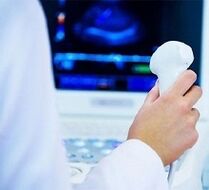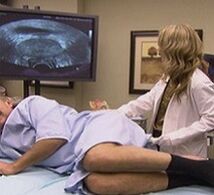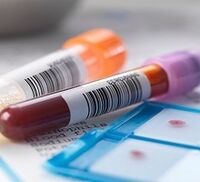How to determine prostatitis?This question is often asked by doctors.According to doctors, only a comprehensive examination can identify the prostate inflammatory process.
Oral survey and physical examination are performed to diagnose.In addition, the doctor prescribes instrumental and laboratory tests for the patient.Based on the data obtained, final diagnosis and treatment tactics are selected.
Prostatitis can be eliminated or surgically.Priority is always medication.Surgical interventions are only prescribed if the abscesses, other complications or other complications of the disease develop.
What are the symptoms of prostatitis?
Prostatitis is a disease in which prostate iron is inflamed.In this case, the body size and swelling may increase.As a result of the development of inflammatory processes, dysuric disorders occur, the quality of the sperm decreases and the sexual disorders develop.
How to identify prostatitis in humans and distinguish it from other pathologies?Everything is quite simple because this disease has characteristic properties.But unfortunately, the disease can be asymptomatic for a long time, so it is often diagnosed in later stages.
So the following signs are in prostatitis:
- Dysuric disorders.The disease can manifest itself with frequent urination, intermittent urination and even urinary retention.At night, the patient is tortured by false urination.After emptying the bladder, a feeling of incomplete emptying may occur.
- Pain.In the case of prostatitis, the thigh hurts.The severity of the symptom increases during urination and sexual intercourse.The pain can be radiated to testicles, back and penis.
- Constipation.Stagnant prostatitis can be observed in chronic form.
- Violation of sexual function.In the patient, efficiency and libido decrease early ejaculation.Sometimes a person, on the contrary, is difficult to complete during sex.The severity of the orgasm with prostatitis is reduced.
- The appearance of blood or mucosa in the urine.However, severe itching in the urethra may occur during urination.These symptoms are observed with the bacterial form of the disease.
- Reduction of sperm quantitative and qualitative indicators.
- Nausea, chills, fever, general weakness, smear in the body.These properties are characterized by acute bacterial prostatitis.
Important!When the above signals appear, contact the urologist immediately.
How is the diagnostics perform?
Physical control and oral survey

Let's look at the issue of prostatitis in more detail in men.First, the patient should consult a urologist.The doctor necessarily examines the patient's history and reveals that one has previously chronic diseases in the Genitourinary System.
Initially, physical examination of the prostate is performed.The doctor inserts your finger into the patient's anus and checks the iron.It is very easy to distinguish a healthy prostate from the patient.If the organ becomes inflamed, the Medic notes that the pancreas is swollen and heterogeneous.Basically, at this stage, it is possible to diagnose prostatitis.
An oral survey is conducted to achieve the exact clinical picture.The urologist clarifies:
- What lifestyle does the patient lead.
- How long have symptoms of prostatitis appear.
- There were previously infectious/viral diseases.
- What is the concern about the patient's labor activities.
- That the patient handed over the operations in which interventions were carried out in the pelvic organs.
Important!In addition, the doctor can perform physical examination of the scrotum.The doctor draws attention to the size, shape and consistency of the scrotum and the mobility of the testicles.
Instrumental diagnostics

A instrumental diagnosis is necessarily required to identify prostatitis.The main diagnostic event is the ultrasound of the prostate gland (ultrasound).
Ultrasound is carried out in several ways.The organ can be examined through the first abdominal wall or with a special transrectal sensor.You can get a more accurate clinical picture when using the sensor.
They can be appointed with ultrasound:
- Urofloometry.
- MRI prostate gland.
- CT prostate.
Important!In the case of suspicion of benign/malignant tumors, the biopsy of the gland organ is recommended to the patient.
Laboratory

Prostate inflammation must be done with many tests.Laboratory diagnostics will understand exactly what provoked pathogenic processes in the glandular organ and whether prostatitis is in this case bacterial/infectious nature.
Above all, patients prescribe blood tests on PSA -N - prostate specific antigen.Analysis is required to find out that there is a tendency to DHC/cancer.Usually the dog level should strive to zero.
In addition to blood tests on PSA:
- Spermogram.
- General blood test.
- Cytological, general and bacteriological urinary analysis.
- Smear from the urethra.
- Study of the secretion of the pancreas.
- Research: PCR.
Important!Based on the data obtained, the doctor can make the final diagnosis and select the treatment tactics accordingly.
How to treat prostatitis?

With the recognition of prostate inflammation, everything is extremely clear.Let's now consider the methods of treating prostatitis.So, as we have noted above, there are two ways to solve the problem - conservative or surgical treatment.
Surgery intervention is prescribed when prostatitis is accompanied by complications such as DGPZ, abscess, urinary tract, anuria, the appearance of stones in the glandular organ.Three main methods are used - prostatectomy, prostate resection and laser therapy.
Conservative treatment is more advantageous and is used in the vast majority of cases.This will ensure:
- Healthy lifestyle.The patient must understand that bad habits slow down the restoration process.We need to reject cigarettes and alcohol once and for all.
- Balanced diet.In urological diseases, it is imperative to keep the diet.We recommend that you remove fatty foods, semi -experiments, fast food, fried foods from your diet.Also prohibiting carbonated drinks, because they cause intestinal irritation, which is not useful for prostatitis.
- Visiting physiotherapy procedures.Acupuncture, moxotherapy, electrophoresis, UVT, Thai massage can get rid of inflammatory processes.The prostate massage is also very useful.
- Avoiding hypothermia as this is the main cause of stagnant prostatitis.
- Taking certain drugs for prostatitis.Antibiotics, bioregulatory peptides, alpha-1-sells, NSAIDs, antispasmic and phytopreerations are prescribed.
- Drive a full -fledged sex life (if possible).If a person is abstained from sex, you can get prostatitis again after therapy.Sexual activity with inflammation of the pancreas will be useful.The most important thing is to use a barrier to contraception.
In addition, patients can use folk treatment methods.But it should be remembered that these are nothing more than a supplement.Inflammation of the pancreas, Aspen decoction, honey down, chamomile microclisms are useful.


























